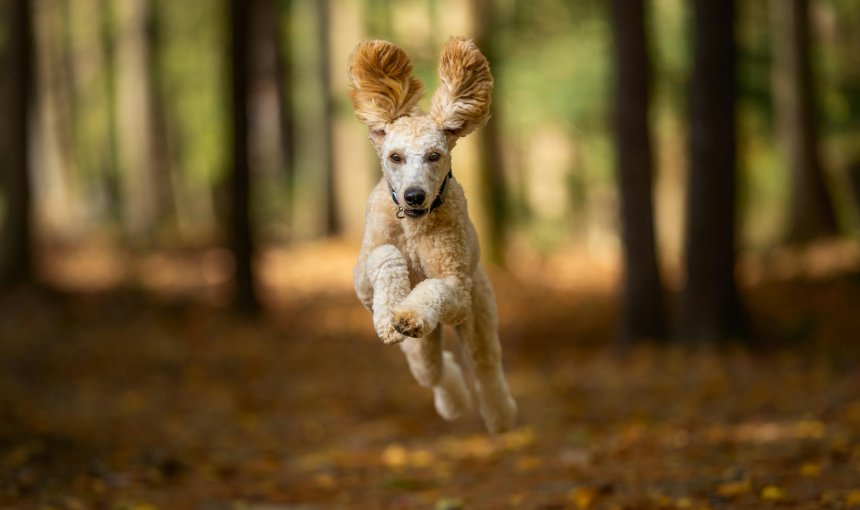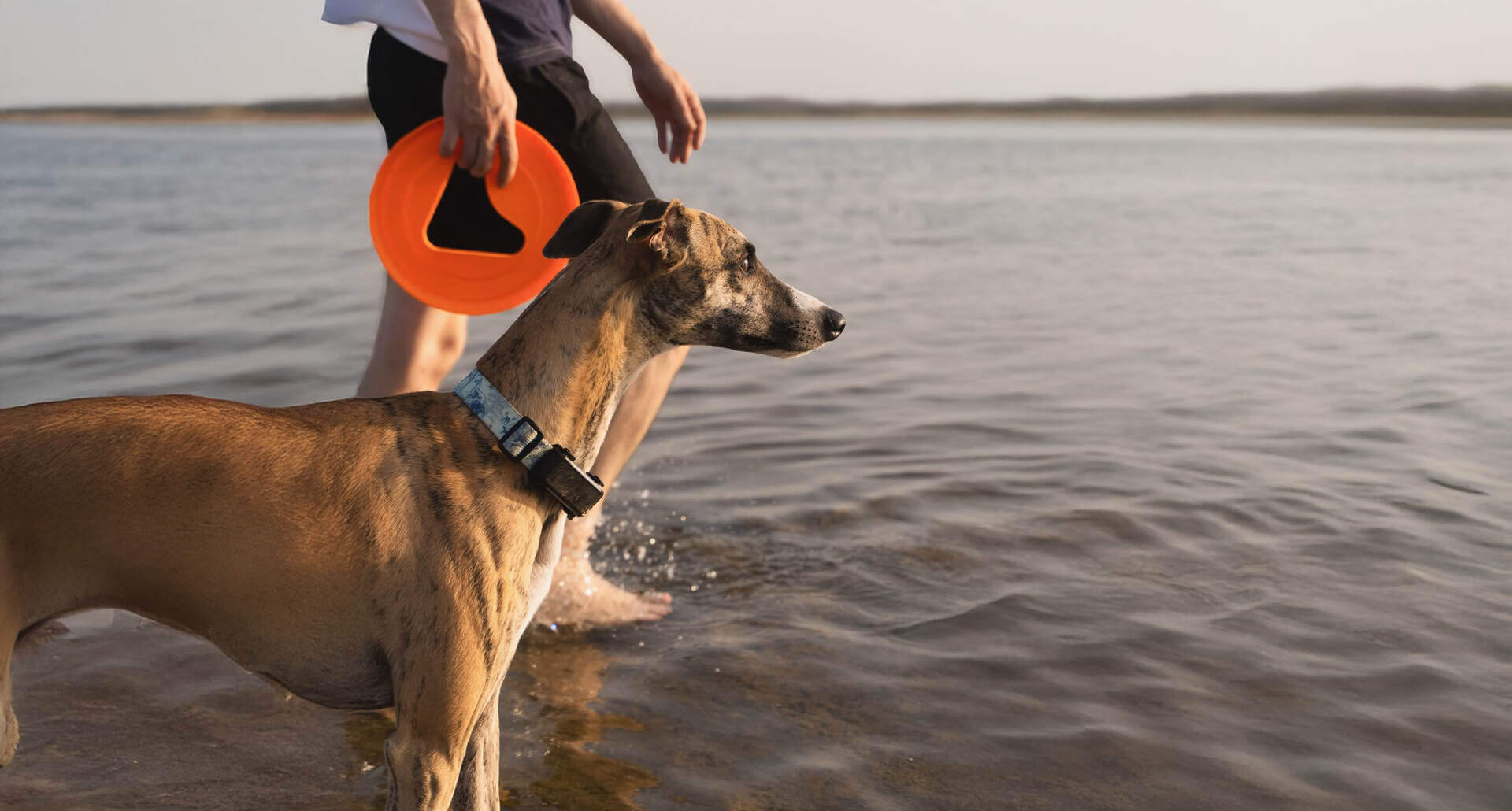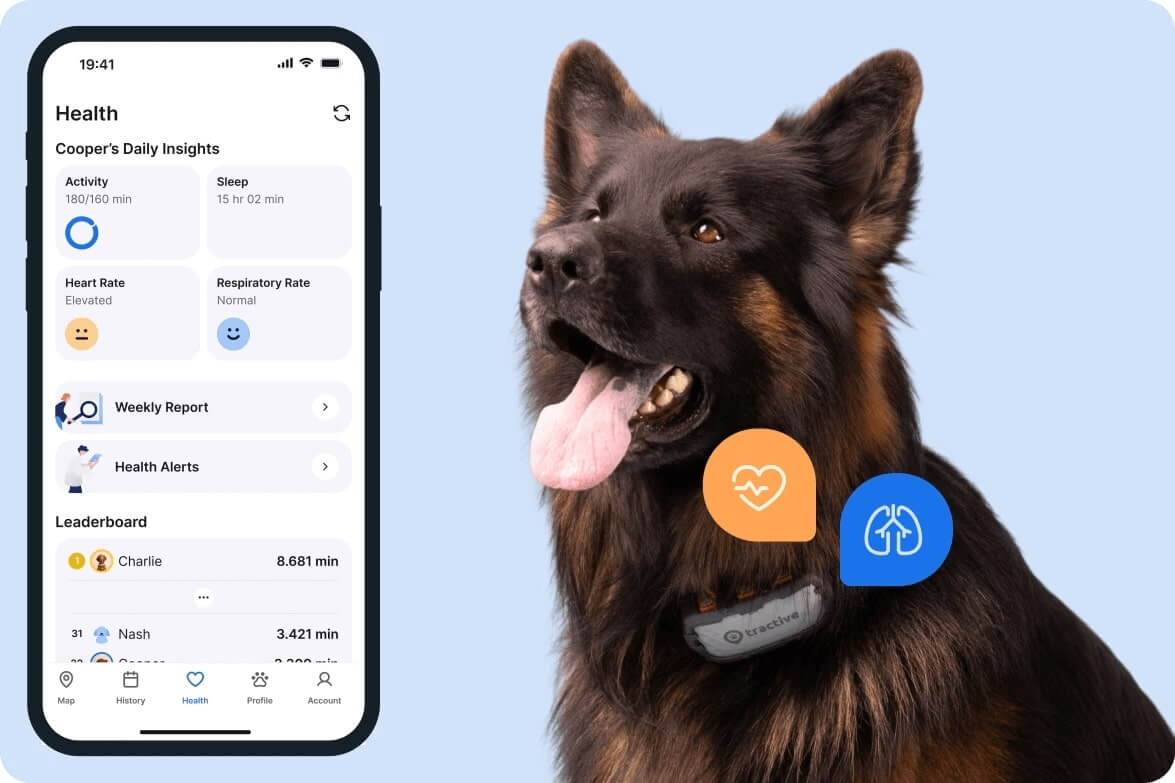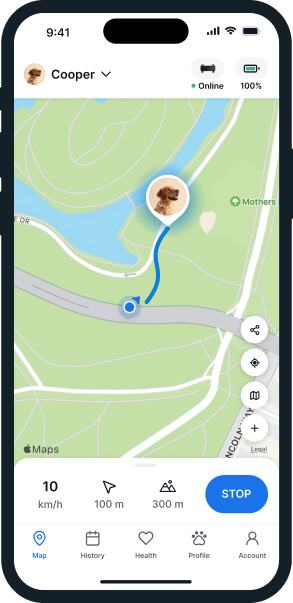10 Of The Fastest Dog Breeds For Your Outdoor Adventures
Fan of dog sports, agility competitions, or just daily walks, runs & hikes? Looking for a training buddy? Here are some of the world's fastest dog breeds that'll keep you on your toes!

Whether you’re training for dog sports or just want a running partner – wouldn’t you want a buddy that loves to be on the move as much as you do? Makes investing in one of the fastest dog breeds a smart choice for your adventures. Here are 10 of them – and how you can keep them safe in case they run or wander off the next time you’re out running or training outdoors.

Always know your buddy is healthy & safe
Read moreHow fast can the average dog run?
Big or small, the average dog clocks in a speed of 15-20 miles (24-32 km) per hour – way faster than the average human.1 There are slow-moving dog breeds as well – like Basset Hounds and some brachycephalic dog breeds. (Which can only run around 5-10 miles/8-16 km per hour.) The world’s fastest dog breeds can easily reach speeds of around 40-45 miles/64-72 km per hour – especially if they’re motivated!
Where a fast, active dog might need extra care
When it comes to active, fast-running, high-energy dog breeds, you’re more likely to find them:
- Getting bored easily (and destructive) if you aren’t keeping up with their energy
- Getting distracted easily while out running or on hikes (especially if they’re from a breed with a high prey drive)
- More likely to escape at greater distances, especially if they’re spooked or stressed out
Finally, if your dog’s still a puppy or untrained, they might be more likely to run away from home. (And not know how to find their way back to you.) In these cases a smart dog tracker with GPS tracking can be a lifesaver. With just a glance at your phone, you’ll be able to track their every step in real-time. Plus, also figure out their distance covered and how many calories they’ve burned.

Follow your dog anywhere
Get real-time location information, wherever they go. And find out when they try to make an escape, or just when they go somewhere they shouldn’t, with Virtual Fences.
So here are 10 of the world’s fastest dog breeds – and what extra steps you can take to help them live their best, happiest, safest life by your side.
10 of the fastest dog breeds from around the world
Salukis
Salukis originate from the Arabian peninsula – where they were once bred to hunt by the side of royalty. Much like Greyhounds, Salukis clock in a running speed of around 45 miles/72 km per hour! With their slender builds and long, lean legs, they’re sometimes referred to as “gazelle hounds” or even the Persian greyhound.
⚠️ Just watch out for your Saluki’s prey drive – these were former hunting dogs, after all! Which means they might be likely to chase down other pets, moving objects, or woodland animals outdoors. (Or run off during a hike or a run in the forest.) Plus, with their independent temperaments, Salukis might not always return to you if you let them off-leash. So make sure you’ve invested in recall training and basic commands.
Greyhounds
Officially the fastest dog breed in the world, a running Greyhound is a sight to behold. Clocking in at 47 miles/75 km per hour, these slender dogs were once raised for racing and hunting down smaller woodland animals. (Though you’re more likely to find one of these goofballs as a family pet these days – especially since a ton of Greyhounds have now retired from their racing days.)
Much like Salukis, Greyhounds also have a strong prey drive. That’s where artificial lures (like a mechanically operated toy or even a drone) can come in handy. Your Greyhound will love to chase around and follow balls, frisbees, or even a “lure” (like a treat) dangling from a stick around!
Sloughis
Ever heard of a dog originating from North Africa? Now you do! Sloughis are distant cousins of the Saluki and have been around since the Neolithic era, hunting and guarding families and bonding deeply with them. They’re primarily found in Egypt, Tunisia, Algeria, Morocco, and Libya. Much like their cousins, they can reach running speeds of up to 42 miles/67 km per hour – often over long distances.
Afghan Hounds
Easily the most eye-catching of the fastest dog breeds, Afghan Hounds originate from the cold, mountainous terrain of Afghanistan. They’re capable of reaching running speeds of around 40 miles/64 km per hour.
Whippets
A cousin of the Greyhound, Whippets are a medium-sized dog breed that’s absolutely built for the chase. With their streamlined bodies and cat-like paws, they can reach running speeds up to 35 miles/56 km per hour. Much like terriers, Whippets were once used as “ratting” dogs – meant to chase away rats and other vermin. And much like their fellow sighthound cousins, they’re curious, inquisitive, and highly prone to escape attempts due to getting spooked or sniffing out prey. Here’s one wearing a Tractive GPS tracker for max safety:

“Only 10 months old, (our littlest Whippet, Polliwog)…got spooked at a hobby racing event and slipped through a fence. She was lost on the Eastern plains of Colorado in the heat of summer, 150 miles from home. Our second close call came when 3 of our young males lit out after a squirrel or cat in town, during rush hour traffic…one of the boys, Fermi, had traveled 4 miles in just 15 minutes!
After that second close call, I decided we needed a GPS tracking solution for my pack. After using a different, popular (but unreliable) GPS system for almost 2 years and being disappointed with quality, I finally found Tractive’s GPS dog trackers early in 2015. I couldn’t be happier.”
– Jennifer Hime, owner and lead trainer of Front Range K9 Academy and the owner of Horsetooth Whippets Kennels, Denve
Read more: Lost Whippet: How Tractive GPS Is A Lifesaver
Weimaraner
The fastest dog breeds around the world aren’t necessarily teeny tiny – Weimanarers, clocking in at 35 miles/56 km per hour, are on the same level as Whippets! They’re a larger-sized breed of dog originating from Germany and were used to hunt down rabbits, foxes, and other game.
Dobermann Pinschers
Another medium-to-large example among the fastest dog breeds is the Dobermann Pinscher – a highly intelligent, loyal, protective dog breed originally from Germany. With a running speed of 35 miles/56 km per hour, they’re a staple among police and military K9 units.
Pharaoh Hounds
A hunting dog originating from Malta, Pharaoh hounds (also known as Kelb tal-Fenek) are hardy, flight-footed dogs who are perfectly at home running over rocky terrain. Much like Whippets, they also clock in a running speed of 35 miles/56 km per hour.
Ibizan Hound
Originating from the Spanish island of Ibiza, Ibizan hounds are another example of lean, medium-sized dogs that double as one of the fastest dog breeds. They can run anywhere between 25-45 miles/40-72 km per hour and love to get up to mischief!
Brittanys
Running at 25 miles/40 km per hour, Brittanys are a small dog breed originating from France. Commonly referred to as the Brittany “Spaniel”, these dogs are…well, not actually part of the Spaniel family! (They’ve actually got more in common with Pointers and Setters than Spaniels.) Which means they’ve got a keen hunting instinct – but are also quite easy to train and sweet-tempered.
Where a smart dog tracker can prevent an emergency
You’re out for a run, or just enjoying some off-leash time at the park, and a squirrel darts by. In a split second, your dog is gone, and your heart is in your throat. This is where a smart dog tracker like Tractive can go from a neat gadget to a total lifesaver. Strapped to your dog’s collar, here’s how it gives you a full safety net designed specifically for speedy dogs and their active humans.
Real-time GPS tracking
With a dog that can reach top speeds, every second matters. Tractive’s real-time GPS tracking updates your dog’s location every couple of seconds. You won’t be just looking for them hours later; you can react right away and maybe even head them off before they hit a busy street. And since the range is unlimited – unlike an AirTag – you can track your pup even if they’ve sprinted way out of sight.
Virtual Fences
Think of this as an invisible, custom-made safety zone you set up on your phone. If your dog steps outside this area – like the boundary of your yard, a specific dog park, or a training field – you’ll get an escape alert on your phone instantly. It’s a fantastic extra layer of security, especially if your dog is a professional escape artist. Or you’re together somewhere new.


Activity Tracking
Tractive is also a health tracker. It keeps an eye on your dog’s activity, including calories burned and how far they’ve run. This is super helpful for high-energy breeds, making sure they’re getting the right amount of exercise to stay happy and healthy.

Plus, by keeping tabs on their activity and sleep patterns, you might spot a health issue early on, preventing an emergency before it even happens. It’s all about proactive care for your best friend.




